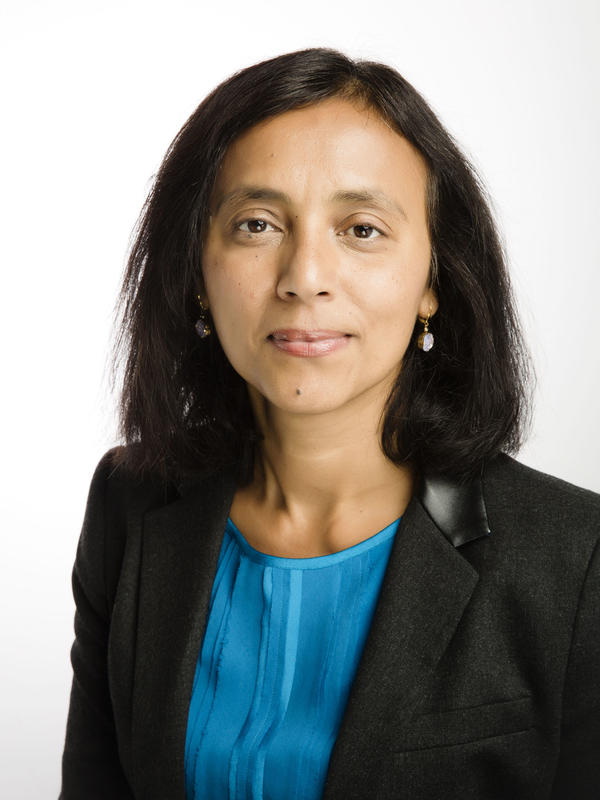When it comes to research in astrophysics, the use of gamma-ray telescopes to detect high-energy light sources from galaxies far away is a fairly new practice — one that Barnard helped pioneer. This year, at a June 1 meeting of the American Astronomical Society, the Cherenkov Telescope Array (CTA) consortium announced that its members used a version of the telescope to detect high-energy gamma rays from the Crab Nebula, a supernova remnant adopted as a reference source in gamma-ray astronomy. The team used an inventive prototype called the Schwarzschild-Couder Telescope (pSCT), effectively confirming that their new telescope’s design has application for future astrophysics research.
 Several members of the Barnard community have been essential to this international project, a collaboration between the United States, Italy, Germany, Japan, and Mexico, with funding from the U.S. National Science Foundation Major Research Instrumentation Program. Reshmi Mukherjee, Barnard’s Helen Goodhart Altschul Professor of Physics & Astronomy, is the College’s principal investigator on the project. Simultaneous input from VERITAS (Very Energetic Radiation Imaging Telescope Array System), one of Mukherjee’s primary research projects, helped prove the viability of the new telescope’s design.
Several members of the Barnard community have been essential to this international project, a collaboration between the United States, Italy, Germany, Japan, and Mexico, with funding from the U.S. National Science Foundation Major Research Instrumentation Program. Reshmi Mukherjee, Barnard’s Helen Goodhart Altschul Professor of Physics & Astronomy, is the College’s principal investigator on the project. Simultaneous input from VERITAS (Very Energetic Radiation Imaging Telescope Array System), one of Mukherjee’s primary research projects, helped prove the viability of the new telescope’s design.
The news of the sighting of the Crab Nebula by the pSCT was announced at the 236th meeting of the American Astronomical Society on June 1.
Today, these studies have succeeded with the detection of the Crab Nebula. This discovery clearly demonstrates the power of the pSCT, and the research capabilities afforded by gamma-ray technology are expansive. Some of the universe’s greatest enigmas, including black holes and dark matter, can be demystified by these high-energy photons of gamma rays. This technology will play a central role in future astrophysics research.
The telescope project drew from sources across the Barnard-Columbia campus, including Barnard postdoctoral scholars Qi Feng and Massimo Capasso. Capasso was responsible for analyzing data on how to calibrate the positioning of the telescope, and spoke of the encouraging results from the pSCT. “I started studying the camera sensors when I was in Italy,” said Capasso. “Now I can continue to contribute to the project as a researcher at Barnard, and this result is surely an important motivation.” The project also provided scholarship and research opportunities to students at Barnard. Recent graduate Kathryn Brady ’20 worked on the initial stages of software development for the telescope data’s “quicklook” program.

Inaugurated in 2019 at the Fred Lawrence Whipple Observatory in Arizona, the pSCT uses an intricately designed system of bowl-shaped mirrors and cameras to capture and record the flashes of light, or Cherenkov radiation, caused by gamma-ray photons (TeV energies) striking the atmosphere. Mukherjee is currently leading a team that received a grant from the National Science Foundation in 2018 to build a complete, more powerful camera for the telescope.
“The new camera will offer unprecedented details of air shower images generated by gamma-ray events from astrophysical objects. It will function like a high-speed, high-resolution digital camera taking pictures of the night sky at a billion frames per second,” said Mukherjee. TeV gamma rays were first detected at pSCT’s site of construction and have been a point of interest for scientists ever since.

consortium.
The news of the sighting of the Crab Nebula by the pSCT was announced at the 236th meeting of the American Astronomical Society on June 1.
Today, these studies have succeeded with the detection of the Crab Nebula. This discovery clearly demonstrates the power of the pSCT, and the research capabilities afforded by gamma-ray technology are expansive. Some of the universe’s greatest enigmas, including black holes and dark matter, can be demystified by these high-energy photons of gamma rays. This technology will play a central role in future astrophysics research.

—ISABELLA PECHATY ’23
